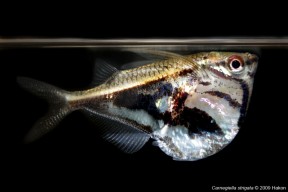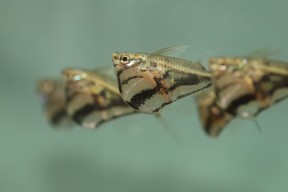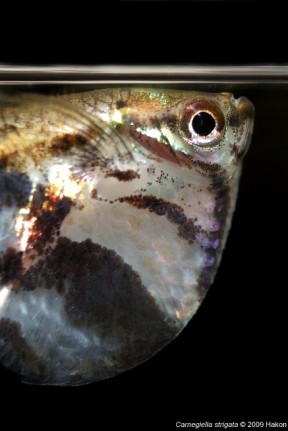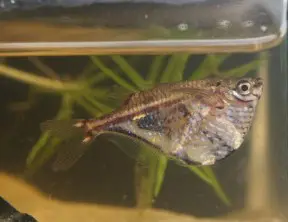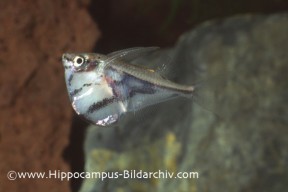Carnegiella strigata
Marbled Hatchetfish
SynonymsTop ↑
Gasteropelecus strigatus Günther, 1864; Gasteropelecus fasciatus Garman, 1890; Carnegiella strigata vesca Fraser-Brunner, 1950; Carnegiella strigata marowini Hoedeman, 1952; Carnegiella strigata surinamensis Hoedeman, 1952
Etymology
Carnegiella: erected in 1909 by C.H. Eigenmann for the type species C. strigata (which was at that time named Gasteropelecus strigatus); the name honours Miss Margaret Carnegie and was chosen to represent the gracefulness of these fish.
strigata: from the Latin strigatus, meaning ‘having transverse bands of colour, strigate’.
Classification
Order: Characiformes Family: Gasteropelecidae
Distribution
Currently accepted to have an enormous range throughout Amazonian Bolivia, Brazil, Peru and Colombia plus the Río Orinoco system in Venezuela and some coastal drainages in Guyana and Suriname but this may be open to question (see ‘Notes’).
There is no type locality since the species was described from an old collection.
The majority of fish in the ornamental trade are collected in the rio Negro basin, Brazil.
Habitat
Appears to be an exclusive inhabitant of blackwater environments.
In the rio Negro system it inhabits so-called igapó and igarapé habitats characterised by thick, often overhanging, riparian vegetation and substrates covered in fallen branches, tree roots and leaf litter.
The water is typically acidic, of negligible carbonate hardness and conductivity and stained brownish due to the presence of humic substances released by decomposing organic matter.
The Negro has a substantial floodplain and the water level can rise by up to 15 metres during the annual wet season.
During the period of inundation small fishes such as C. strigata move upstream within the river’s tributaries and then laterally into the flooded forest itself to feed and reproduce, before returning to the tributaries when the water falls.
Maximum Standard Length
30 – 35 mm.
Aquarium SizeTop ↑
Surface dimensions of 75 ∗ 30 cm or more are recommended since this species should be maintained in numbers (see ‘Behaviour and Commpatibility’).
Maintenance
Should ideally be kept in a heavily-planted set-up, preferably with a dark substrate and some patches of floating vegetation around which the fish will tend to congregate since they spend almost all of their time at or towards the surface.
Driftwood branches and dried leaf litter can also be added, the latter in particular driving establishment of microbe colonies as decomposition occurs.
Such microorganisms can provide a valuable secondary food source for fry, whilst the tannins and other chemicals released by the decaying leaves are also thought beneficial.
Water movement should be gentle to moderate and be sure that the aquarium cover is tightly-fitting as this species may jump when startled (but see ‘Notes’).
Water Conditions
Temperature: 20 – 28 °C
pH: 4.0 – 7.0
Hardness: 18 – 179 ppm
Diet
Primarily a predator feeding on terrestrial and aquatic invertebrates and other zooplankton taken at or near the water surface in nature.
In the aquarium it will accept dried foods of a suitable size but should also be offered regular meals of small live and frozen fare such as Artemia nauplii, Daphnia, Moina, grindal worm, etc.
Small insects such as young crickets or Drosophila fruit flies are also suitable to use although it’s best to fill the stomachs of these by feeding them fish flakes or some kind of vegetable matter before offering them to the fish.
Behaviour and CompatibilityTop ↑
Very peaceful but does not make an ideal community fish due to its small size and rather timid nature.
In a community it’s best kept with similarly-sized, peaceful characids and smaller callichthyid or loricariid catfishes.
It also makes an ideal dither fish for Apistogramma spp. and other dwarf cichlids since it tends to inhabit the middle-to-upper regions of the tank, and does not actively predate fry.
It’s very much a gregarious animal so buy as many as possible, ideally 10 or more, as when kept in larger groups any aggression is spread between individuals plus the fish are bolder and exhibit more natural behaviour.
Sexual Dimorphism
Some specimens do grow larger and become rounder-bodied than others, and presumably these represent adult females.
Reproduction
Unrecorded.
NotesTop ↑
C. strigata is an enduringly popular species in the aquarium hobby but is not bred on a commercial basis with all fish offered for sale collected in the wild.
It can be told apart from other members of the genus by its larger adult size and dark, marbled colour pattern appearing as a series of dark and light stripes running diagonally across the body below the lateral line.
This colour pattern is variable and populations are also known to exhibit differences in body depth and the number of anal-fin rays with this having led to the description of several subspecies, namely C. strigata fasciata (Garman, 1890) was described from Tabatinga, Brazil, near the ‘Três Fronteiras’ where the borders of Brazil, Peru and Colombia meet , C. strigata vesca (Fraser-Brunner, 1950) from the Mazarumi River, Guyana, C. strigata marowini (Hoedeman, 1952) from the Marowini River, Suriname and C. strigata surinamensis (Hoedeman, 1952) from an unnamed swamp in northern Suriname.
Géry (1977) referred to these subspecies as ‘forms’ and chose to recognise two as distinct; C. strigata strigata with an essentially ‘V’-shaped colour pattern found in Guyana, Suriname and parts of the Amazon, and C. strigata fasciata with a ‘Y’-shaped colour pattern found throughout the Amazon, while also noting the existence of an intermediate form inhabiting the rios Negro and Orinoco.
Although all of the above are currently considered synonymous with C. strigata this may be subject to change in the future given the results of a paper published in 2012 by Schneider et al. in which the rio Negro populations alone were found to represent two distinct, monophyletic lineages.
The first of these was recorded in the Urubaxi, Mauá, Pixirituba, Zamula, Maquari, Jacundá, Cajuri and Tarumã tributary drainages of the river and the second in the Cajarizinho and Cajuri tributaries plus the rio Uatumã.
The latter drains into the Amazon main channel several hundred kilometres downstream of the Negro but its headwaters are much closer and the two may once have been connected, or indeed still are during periods of high water.
The authors found that genetic flow between the lineages was completely restricted even when they occured together (two specimens of the first lineage were recorded in the rio Cajuri), suggesting them to represent distinct species with a genetic distance intermediate to that existing between C. strigata and the congener C. marthae.
The family Gasteropelecidae is separated from other Characiformes by the following combination of characters: frontal bone longitudinally corrugated with a strong longitudinal ridge; posttemporal and supracleithrum fused into a single bone; pelvic fins and associated bones minutehey; presence of an enlarged, strongly convex muscular pectoral girdle region, consisting of greatly expanded coracoids fused to a single fan-shaped and corrugated median bone; lateral line extending ventroposteriorly to approach the anal-fin insertion; 0-2 or 3 scales behind head and one or very few scales on caudal-fin base; 10-17 dorsal-fin rays; 22-44 anal-fin rays; adipose-fin present in larger species, absent in smaller species.
There are currently three valid genera of which Carnegiella is the most speciose with four members.
Gasteropelecids are commonly-referred to as ‘freshwater hatchetfishes’ due to their heavily-keeled body shape which has evolved in such a way due to possessing an enlarged, heavily-muscled pectoral girdle, and which resembles the shape of a hatchet head.
They are sometimes said to be capable of propelled flight above the water surface by beating their pectoral fins but in fact this is not the case and was disproven by Wiest (1995) who used hugh speed video photography to demonstrate that the pectoral fins are used in leaving the water but not while the fish is in the air.
The action is more accurately described as a powerful jump and is actually a modified threat response which only appears to be used in extreme circumstances much like in many other fishes.
The researcher also found that the fish only seem to be able to jump once or twice before requiring a rest period due to the large amount of energy required to work the massive pectoral girdle muscles, and when fatigued their threat response is comparable to that of other small species in that they dive towards the substrate.
In addition anecdotal evidence from fish collectors and icthyologists working in the field would suggest that gasteropelecids rarely jump and they also tend not to do so in aquaria, even when being chased with a net (pers. obv.).
Characiformes is among the most diverse orders of freshwater fishes currently including close to 2000 valid species distributed among 19 families.
This tremendous taxonomical and morphological diversity has historically impaired the ability of researchers to resolve their genetic relationships with many genera remaining incertae sedis.
A further limiting factor has been that in many cases exhaustive study of these on an individual basis is the only way to resolve such problems.
Modern molecular phylogenetic techniques have allowed some headway, though, and research papers by Javonillo et al. and Oliveira et al., published in 2010 and 2011, respectively, revealed some interesting hypotheses.
The results of the former suggest that Gasteropelecidae forms a monophyletic clade nested within the family Characidae, while the latter expanded on this and concluded that within the family Carnegiella is the sister group of Gasteropelecus with Thoracocharax sister to that clade, and that Gasteropelecidae appears most closely-related to the authors’ expanded Bryconidae which contains the genera Brycon, Henochilus and Salminus.
Others such as Oliveira et al. (2011) have concluded that the family Erythrinidae is also closely-related to this grouping with Hepsetidae and Alestidae more distant.
References
- Günther, A., 1864 - Catalogue of the fishes in the British Museum v. 5: i-xxii + 1-455
Catalogue of the Physostomi, containing the families Siluridae, Characinidae, Haplochitonidae, Sternoptychidae, Scopelidae, Stomiatidae in the collection of the British Museum. - Javonillo, R., L. R. Malabarba, S. H. Weitzman and J. R. Burns, 2010 - Molecular Phylogenetics and Evolution 54(2): 498-511
Relationships among major lineages of characid fishes (Teleostei: Ostariophysi: Characiformes), based on molecular sequence data. - Oliveira, O., G. S Avelino, K. T. Abe, T. C Mariguela, R.C Benine, G. Ortí, R. P. Vari and R. M. Corrêa e Castro, 2011 - BMC Evolutionary Biology 11: 275
Phylogenetic relationships within the speciose family Characidae (Teleostei: Ostariophysi: Characiformes) based on multilocus analysis and extensive ingroup sampling. - Ortega, H. and R. P. Vari, 1986 - Smithsonian Contributions to Zoology No. 437: iii + 1-25
Annotated checklist of the freshwater fishes of Peru. - Reis, R. E., S. O. Kullander and C. J. Ferraris, Jr. (eds.), 2003 - EDIPUCRS, Porto Alegre: i-xi + 1-729
Check list of the freshwater fishes of South and Central America. CLOFFSCA. - Schneider, C. H., M. C. Gross, M. L. Terencio and J. I. R. Porto, 2012 - Journal of Fish Biology 81(4): 1210-1224
Cryptic diversity in the mtDNA of the ornamental fish Carnegiella strigata. - Weitzman, S. H. and L. Palmer, 1996 - Tropical Fish Hobbyist 45(1): 195-206
Do freshwater hatchetfishes really fly? - Wiest, F. C., 1995 - Journal of Zoology 236(4): 571-592
The specialized locomotory apparatus of the freshwater hatchetfish family Gasteropelecidae.

